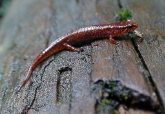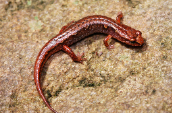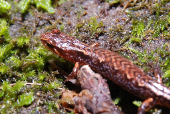Pygmy Salamander (Desmognathus wrighti)
Description: D. wrighti has a light belly with a gold-colored iridophore pattern that extends from the abdomen to the anterior of the cloacal vent. The salamander has a rounder snout and the total body length ranges from 1.4 to 1.7 inches. The tail is not keeled and the body length is equal to or greater than the tail length. Pygmy salamanders are typically light brown with dark brown pigment on the dorsal side forming an inverted V-shape marking down the back This 'V' shape marking is a classic pigmentation marking. The salamander's color can range from brick red to yellow but usually is found as a light brown shade. The light stripe from the eye to the jaw designates the salamanders as a desmognathan. Desmognathus wrighti typically has six vomerine teeth on each side of the mouth along with premaxillary and mandible teeth. The maximum size of males and females has been determined to have no real difference in the species.
Habitat: In its known geographical locations the pygmy salamander can primarily be found in moist depressions such as under logs and rocks along streams, in damp leaf litter, and in mossy areas.
Range: D. wrighti has a very fragmented geographical distribution. The species is found in the Southern Appalachian Mountains of North Carolina and Tennessee south of the French Broad River. In Tennessee, D. wrighti inhabits the Great Smoky Mountains National Park in Blount, Cocke, and Sevier counties. The species is also found in the Cherokee National Forest in Monroe County. In North Carolina, the pygmy salamander is only documented in Graham County along the Tennessee border. The highest abundance of pygmy salamanders is found at higher elevations ranging from 1600 to 2082 meters. The distribution of the salamander primarily lies adjacent to areas of red spruce (Picea rubens) and Fraser's fir (Abies fraseri) forests at these high elevations. However, pygmy salamanders populations can be found at lower elevations from 950 to 1400 meters, but the highest densities occur at the higher elevations. D. wrighti populations appear to have stayed fragmented for some time due to their restriction to high elevation. The lower elevation populations of the pygmy salamanders documented exhibit little gene flow. This low gene flow reflects their preference for higher elevation and possible competition with other Appalachian salamanders.
Found in these States:
GA |
NC |
TN
Diet: Soil mites, springtails, moths, beetles, flies, pseudoscorpions, thrips, and spiders.
Reproduction: D. wrighti courtship differs from other members of Desmognathus in the phenology of oviposition which is in late summer into autumn. Males reach sexual maturity by their second or third year while females reach their sexual maturity by their third year. Males normally have two testes lobes but this number can increase with body size. In courtship males use their vomerine teeth to bite the female which in turn allows pheromone secretion to enter directly into the female circulation. D. wrighti and D. aeneus are the only two desmognathine salamanders that exhibit the courtship that which the male bite and seizes its partner before behaviors exhibited to accomplish sperm transfer. The male approaches the female quickly, bites, and tugs as he begins to undulate his tail. The female in return turns towards the male and places her chin on his laterally undulating tail so that they rotate in full circle. Typically in courtship behavior a Plethodontidae characteristic tail-straddling walk follows. In the tail-straddling walk, the male release the female and slides his head under her chin, then her forelimbs straddle the male's tail and the pair then move forward. The male then deposits a spermatophore on the ground which is followed by the female picking up a sperm cap with her cloacal lips as she moves forward undulating her pelvic area.
Desmognathus wrighti females have an average clutch size of 8 to 9 eggs which are suspended by a single attachment stalk and develop between 4 and 25 oocytes. Females lay eggs in banks of streams in areas of saturated gravel. The females also typically remain close to their egg mass and coil their bodies around the mass. Eggs change from spheroid shape to ovoids when hatching conditions occur. The embryo then thrusts itself against the capsule and rotates within the egg until it escapes from the egg fluid. D. wrighti hatchlings are not larvae and have gills in late embryonic stages. At hatching the ventral side is unpigmented and the characteristic ‘V’ pigmentation is found on the dorsal side. The characteristic stripe from the eye to the jaw is also present in late embryo and hatching stages.
Status: The species' extent of occurrence (EOO) is 9,453 km2 and there is continuing decline in the extent and quality of its habitat. However it is thought to occur in more than ten threat-defined locations and its population is probably not severely fragmented. It is therefore close to qualifying for Vulnerable under criterion B1 and is listed as Near Threatened.
»» Kingdom: Animalia - Animals
»» Phylum: Chordata - Chordates
»» Subphylum: Vertebrata - Vertebrates
»» Class: Amphibia - (Amphibians)
»» Order: Caudata - Salamanders
»» Family: Plethodontidae - Lungless Salamanders
»» Genus: Desmognathus
»» Species: Desmognathus wrighti - Pygmy Salamander
This article uses material from the Wikipedia article "Pygmy Salamander", which is released under the Creative Commons Attribution-Share-Alike License 3.0. Content may have been omitted from the original, but no content has been changed or extended.
|












